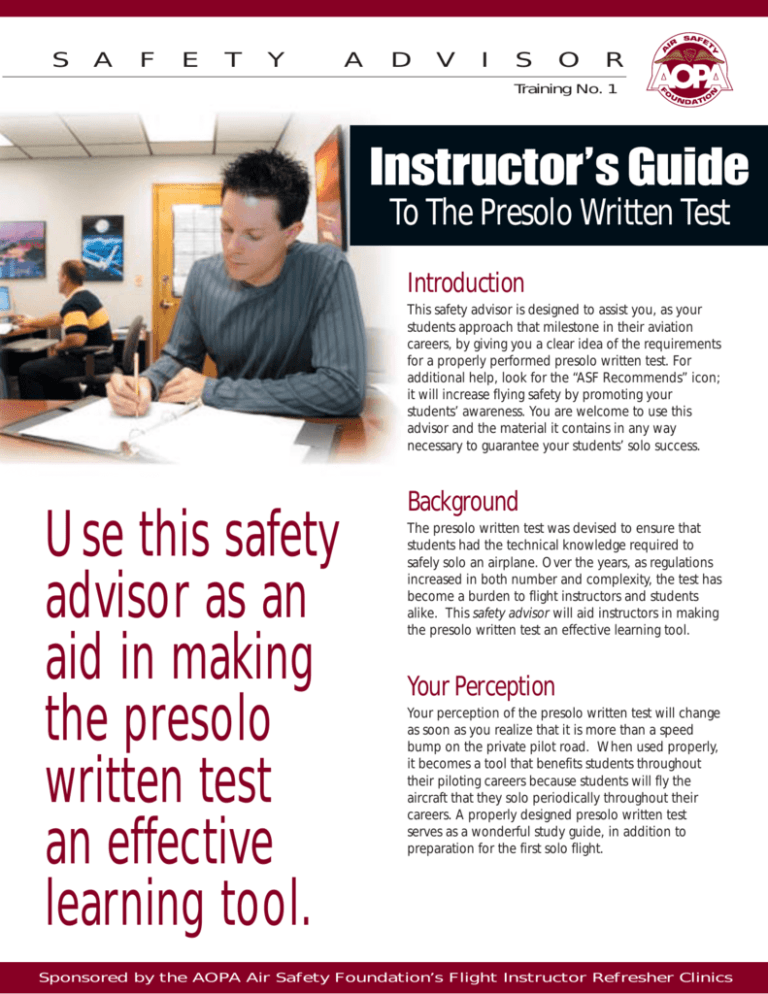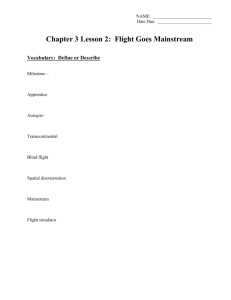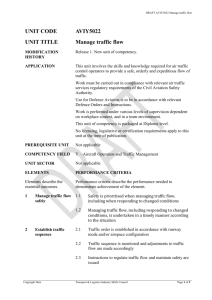PreSolo Written Test - Flight Training
advertisement

S A F E T Y A D V I S O R Training No. 1 Instructor’s Guide To The Presolo Written Test Introduction This safety advisor is designed to assist you, as your students approach that milestone in their aviation careers, by giving you a clear idea of the requirements for a properly performed presolo written test. For additional help, look for the “ASF Recommends” icon; it will increase flying safety by promoting your students’ awareness. You are welcome to use this advisor and the material it contains in any way necessary to guarantee your students’ solo success. Use this safety advisor as an aid in making the presolo written test an effective learning tool. Background The presolo written test was devised to ensure that students had the technical knowledge required to safely solo an airplane. Over the years, as regulations increased in both number and complexity, the test has become a burden to flight instructors and students alike. This safety advisor will aid instructors in making the presolo written test an effective learning tool. Your Perception Your perception of the presolo written test will change as soon as you realize that it is more than a speed bump on the private pilot road. When used properly, it becomes a tool that benefits students throughout their piloting careers because students will fly the aircraft that they solo periodically throughout their careers. A properly designed presolo written test serves as a wonderful study guide, in addition to preparation for the first solo flight. Sponsored by the AOPA Air Safety Foundation’s Flight Instructor Refresher Clinics Presolo Written Test Ideals By leaving any precise requirements for the presolo written test out of the Federal Aviation Regulations, the FAA both blessed and cursed the student pilot. Technically, you are only required to test your student on the applicable regulations, flight characteristics, and operational limitations for the make and model of aircraft to be soloed. If you find that the student can address those requirements using only one question, the test is perfectly legal and ideal for student kamikaze pilots. On the other hand, marathon written tests may result in students canceling all future flight activity to contemplate the origins of the universe. Obviously, a happy medium must be reached if students are to gain anything from the test. ASF recommends using the presolo written test as a valuable teaching tool, rather than treating it as just a required task. The primary objective of any test is to evaluate the student’s knowledge. Tests are also used to reinforce and refresh past learning. If your students are anything like the national norm, book work and studying are rarely priorities. Getting them to study is always a challenge. ASF recommends requiring the student to list the references for each question. The presolo written test goals should include teaching the student specifics, as well as where to locate information. This will force your student into the books, not only learning the requested information but, perhaps more importantly, where to find it. By requiring your student to write the references for each question, you are ensuring that your student will be able to not only find specific references, but also will be able to review any question in the future. This permits the use of the presolo test as a study guide for the private pilot practical test, a future checkout in the aircraft to be soloed, or any time your student would like to brush up on the basics. ASF recommends dividing the test into two sections: a closed-book written quiz and an open-book take-home test. Both the quiz and test should require the student to answer in writing. Average students should complete the quiz portion of the presolo written test in approximately 15 to 20 minutes. The quiz should cover aircraft operational knowledge, such as V speeds and emergency procedures, and be graded immediately upon completion. Any incorrect answers should be corrected that evening during the takehome portion of the test. The take-home portion should take approximately one hour and include items such as FARs, aircraft operational procedures, and local procedures. You should grade the take-home portion of the test in your student’s presence. This allows discussion of any incorrect answers. ASF recommends that the student research and correct all incorrect answers. Once all answers have been corrected, it is wise, although not required, for you to keep the test and record the date, your student’s name, and the test results in the log you keep for sign-offs for a minimum period of three years. In addition, you should make a copy of the correct presolo written test and give it to your student for future reference. Finally, you should use this opportunity to define your student’s personal flight weather minimums. FARs stipulate that students may only fly when the visibility is greater than 3 miles during the day or 5 miles at night. It is wise to further limit this minimum as necessary. For instance, you may want to restrict the lowest ceiling or the maximum wind conditions in which your student may solo. This will teach your students to define their own limitations once they are private pilots. Safe Pilots. Safe Skies. • Pg. 2 Presolo Topics The following is a recommended list of topics that should be covered during each section of the presolo written test: A. Written quiz 1. V speeds and their definitions 2. Aircraft emergency procedures B. Take-home test 1. Aircraft limitations 2. Aircraft operation and maintenance 3. FARs a. Eligibility requirements for student pilots (61.83) b. Solo flight requirements for student pilots (61.87) c. General limitations (61.89) d. Responsibility and authority of the pilot in command (91.3) e. Careless or reckless operation (91.13) f. Dropping objects (91.15) g. Alcohol or drugs (91.17) h. Portable electronic devices (91.21) i. Preflight action (91.103) j. Use of safety belts, shoulder harnesses and child restraint systems (91.107) k. Right-of-way rules (91.113) l. Minimum safe altitudes (91.119) m. Altimeter settings (91.121) n. Compliance with ATC clearances and instructions (91.123) o. ATC light signals (91.125) p. Operating on or in the vicinity of an airport in Class G airspace (91.126) q. Operating on or in the vicinity of an airport in Class E airspace (91.127) r. Operations in Class D airspace (91.129) s. Operations in Class C airspace (91.130), as necessary t. Operations in Class B airspace (91.131), as necessary u. Restricted and prohibited areas (91.133) v. Fuel requirements for flight in VFR conditions (91.151) w. Basic VFR weather minimums (91.155) x. Civil aircraft: Certifications required (91.203) y. Aircraft lights (91.209) z. Aerobatic flight (91.303) 4. Aeronautical Information Manual a. Wake turbulence b. Radio failure procedures c. Airport markings d. Traffic pattern 1. Pattern legs 2. Entry and departure 3. Standard turns 5. Local procedures a. Frequencies 1. Airports 2. Emergency b. Airport procedures 1. Traffic pattern directions and altitudes 2. Noise abatement 3. Particular flight school procedures (as applicable) Conclusion The person with the single greatest influence over a pilot’s career is you, the flight instructor. By choosing to teach in a responsible manner, you have brought safety not only to your student, but also to the aviation community. The presolo written test, when performed under the guidelines of this safety advisor, is just one practice of a professional instructor. Safe Pilots. Safe Skies. • Pg. 3 Appendix A Take-Home Test ASF Sample Presolo Written Test Questions Instructions: Answer each question in the space provided, using the FARs, the AIM, the Airport/Facility Directory, and the Pilot’s Operating Handbook. Use the space to the left of the question number to list the reference for each question. The instructor may pick and choose particular questions to shorten the length of the test. Written Quiz Instructions: Answer each question in the space provided. The instructor may pick and choose particular questions to shorten the length of the quiz. 1. Define and list the following speeds for your aircraft: 1. What is the maximum gross weight of the airplane in the Normal category? VsVso- 2. If a glider is converging with an airplane, which has the right of way? VxVy3. What are the limit load factors in both the Normal and Utility categories with the flaps up and down? VaVfeVno- 4. What preflight action is required of a pilot prior to a flight? Vne- 2. What is the airplane’s best glide speed? When is it used? 5. What is the maximum rpm of your airplane? 6. Define an aerobatic maneuver. 3. List the procedure to respond to an in-flight engine failure. 7. Generally describe the engine in your airplane. 4. List the procedure to respond to an engine fire on the ground while starting. 8. List the definition of careless or reckless operation. 5. List the procedure for loss of communication radio when arriving at an airport with an operating control tower. 9. What is the oil sump capacity in your airplane? What is the minimum? Safe Pilots. Safe Skies. • Pg. 4 10. What is the minimum amount of time after the consumption of alcohol a pilot is required to wait? 20. List the traffic pattern altitude, direction of turns, noise abatement procedures, and all radio frequencies for the following local area airports and their runways. 11. What would happen to the fuel indicators if all electricity in the airplane was lost? 21. What is the fuel capacity? How much is usable? 12. What are the basic VFR weather minimums? What is the minimum visibility for a student pilot? 22. What is the authority and responsibility of the pilot in command? 13. Why is it necessary to drain fuel out of the sumps after refueling and before the first flight of the day? 23. When are you required to wear a safety belt? 14. List and describe each of the light gun signals available from air traffic control. 24. When are you permitted to deviate from an ATC instruction? 15. Will the engine still run if the master switch is turned off? Why? 25. What grade(s) of aviation fuel is/are available for use? What color is each? 16. What are wing-tip vortices (wake turbulence)? With which aircraft are they greatest? Describe proper avoidance. 26. When an aircraft is approaching another headon, each pilot should alter their course to the ______________. 17. What endorsements are required for solo flight? What three documents must you have in your possession to solo an aircraft as a student? 27. A(n) ______________ on the runway indicates that the runway is closed. 18. During runup, what is the maximum allowable rpm drop? 19. Draw an airport traffic pattern, labeling each leg and the proper entry and departure points. Which turn direction is standard for an airport traffic pattern? 28. Draw the pavement marking requiring you to stop before entering a runway. 29. When is dropping objects from an airplane permitted? Safe Pilots. Safe Skies. • Pg. 5 30. The______________________________ of two aircraft on approach to the same runway has the right of way. 31. What must a pilot do before entering Class D airspace? 32. What is the minimum safe altitude anywhere? Over congested areas? 33. List the day-VFR weather minimums in Class G, E, and D airspace. (1) The test must address the student pilot’s knowledge of–– (i) Applicable sections of parts 61 and 91 of this chapter; (ii) Airspace rules and procedures for the airport where the solo flight will be performed, and (iii) Flight characteristics and operational limitations for the make and model of aircraft to be flown. (2) The student’s authorized instructor must–– (i) Administer the test; and (ii) At the conclusion of the test, review all incorrect answers with the student before authorizing that student to conduct a solo flight. References Aviation Instructor’s Handbook, FAA-H-8083-9 FAR Parts 61 and 91 34. List the documents that must be aboard the aircraft at all times. 35. When must the aircraft’s navigation lights be on? 36. What are you, as a student pilot, required to have before operating in Class B airspace? 37. What is the minimum reserve fuel required for day VFR operations? Appendix B FAR Part 61.87 Solo flight requirements for student pilots (b) Aeronautical knowledge. A student pilot must demonstrate satisfactory aeronautical knowledge on a knowledge test that meets the requirements of this paragraph: Safe Pilots. Safe Skies. • Pg. 6 EXPLORE ASF’S WEB PAGE AND ONLINE PROGRAMS SkySpotter® Join the thousands of pilots committed to improving the quality and quantity of pilot reports (pireps). Runway Safety CFI Renewal Renew your certificate online. (Also available to non-CFIs at a reduced price.) Silent Auction Learn how to avoid runway incursions. Bid on unique aviation items, while benefitting ASF. Operation Airspace Airport Taxi Diagrams View this presentation before you fly to learn about special airspace, TFR’s, and interception procedures. Become familiar with the airport layout before you fly there. IFR Adventure ASF Accident Database Learn about IFR regulations with this interactive program. Search this database of general aviation accidents. www.asf.org These ASF programs were made possible through contributions from pilots like you. EXPLORE ASF’S SAFETY PRODUCTS Safety Advisors • Safety Highlights • Nall Report Videos • Seminar-in-a-Box® Program and many more... 421 Aviation Way • Frederick, MD 21701 • 800/638-3101 • www.asf.org • asf@aopa.org These ASF products were made possible through contributions from pilots like you. Safe Pilots. Safe Skies. Copyright © 2003, AOPA Air Safety Foundation 421 Aviation Way, Frederick, MD 21701 800/638-3101 • www.asf.org Publisher: Bruce Landsberg Editors: Kathleen Roy, David Wright, John Steuernagle Consultant: Brandon Taksa SA04-01/03 Instructor’s Guide to the Pre-Solo Written Test









